The municipality of Alangalang, Leyte had a total population of 57,185 persons based on the 2020 Census of Population and Housing (2020 CPH). The household population of 57,178 persons comprised 99.9 percent of the total population recorded as of the time of census-taking.
Of the 57,178 household population in Alangalang, Leyte, 29,326 (51.3%) were males while 27,852 (48.7%) were females. By age group, 19,067 (33.3%) were under 15 years of age (young dependents). On the other hand, persons aged 15 to 64 years (working-age or economically-active population) totaled to 35,011 (61.2%) while those in age groups 65 years and over (old dependents) comprised the remaining 3,100 (5.4%). In 2015, persons aged 0 to 14 years, 15 to 64 years, and 65 years and over accounted for 36.0 percent, 59.2 percent, and 4.8 percent, respectively, of the household population.
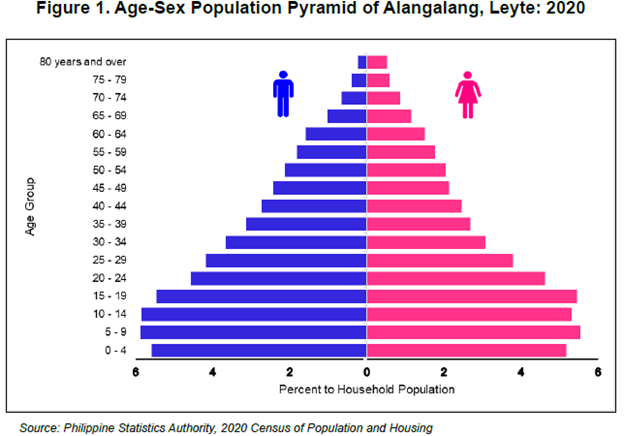
Moreover, there were more males (47.4%) than females (44.1%) among the 0 to 59 age group. However, among the older age group (60 years and over), females (4.6%) outnumbered the males (3.9%). The same trend was also observed in 2015.
Sex ratio stands at 105 males per 100 females
The sex ratio in Alangalang, Leyte was computed at 105 in 2020. This means that there were 105 males for every 100 females. The sex ratio in 2015 was higher at 108 males per 100 females.
In 2020, children aged below 15 years had a sex ratio of 108 males per 100 females. On the other hand, those aged 15 to 64 years had a sex ratio of 107 males per 100 females. Moreover, among those aged 65 years and over, the sex ratio was 73 males per 100 females. This depicts a longer life expectancy among females than males or a higher mortality rate among males than females in the older age groups.
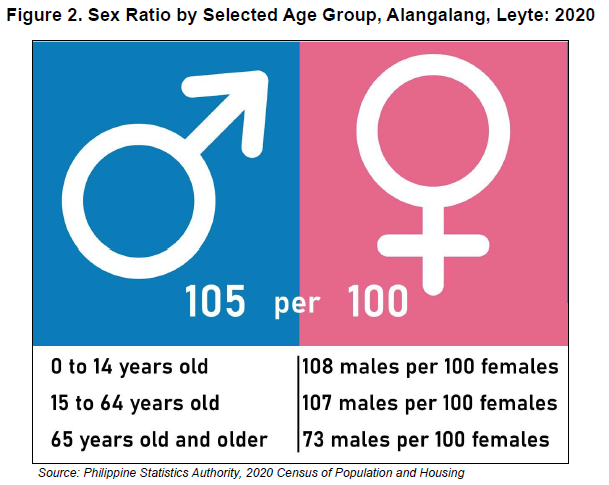
There were more males than females in children under five years old
The sex ratio for children under five years old in 2020 was 108 males per 100 females, higher than the 2015 ratio at 105 males per 100 females. Additionally, children under five comprised 10.8 percent (6,154 persons) of the household population in 2020, a decrease from 12.2 percent (6,726 persons) in 2015.
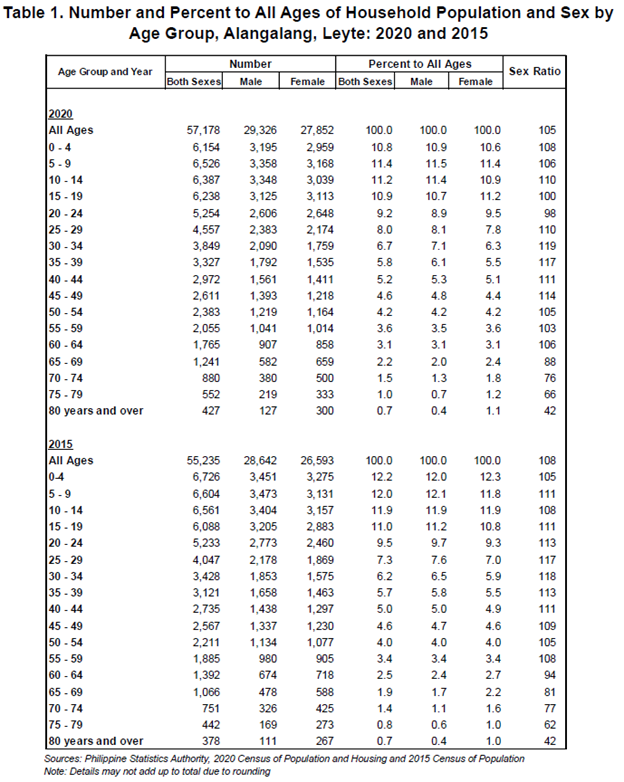
Median age measures at 22.5 years
The median age of Alangalang, Leyte household population continues to increase during the past three censuses. In 2020, the median age was computed at 22.5 years, which means that half of the household population was younger than 22.5 years, while the other half is older than 22.5 years. This is higher than the median ages of 21.3 and 20.4 years that was posted in 2015 and 2010, respectively.
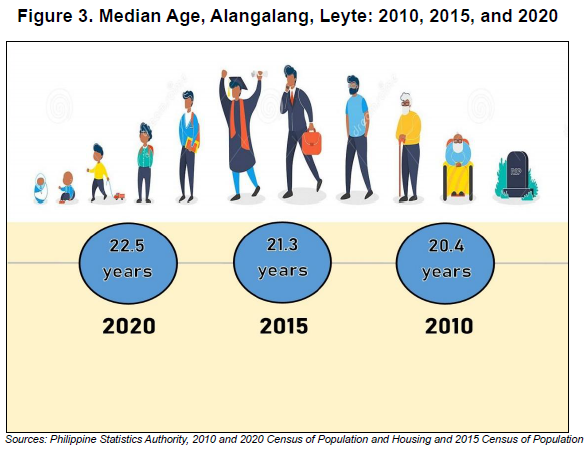
Dependency ratio decreases to 63 dependents per 100 persons in the working-age group
The 2020 overall dependency ratio of Alangalang, Leyte was computed at 63, which indicates that for every 100 working-age or economically-active population, there were about 63 dependents (54 young dependents and 9 old dependents). This is lower than the dependency ratio in 2015, which was recorded at 69 dependents per 100 working-age population (61 young dependents and 8 old dependents).

Two in every five household population are of school age
In 2020, the school-age population (5 to 24 years old) accounted for 24,405 (42.7%) of the household population which is lower compared to the 24,486 (44.3%) school-age population that was reported in 2015. Moreover, there were more males (51.0%) than females (49.0%) of the school-age population in 2020.
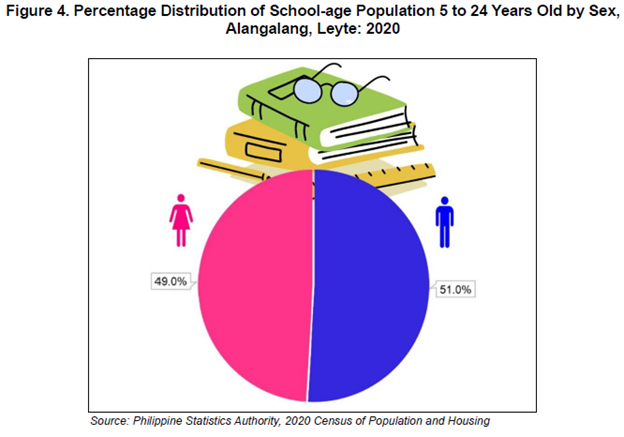
Senior citizens accounts for 8.5 percent of the household population
In Alangalang, Leyte, people aged 60 years old and over are regarded as senior citizens, made up 8.5 percent (4,865 persons) of the household population in 2020, higher than the 7.3 percent (4,029 persons) recorded in 2015. There were more females (54.5%) than males (45.5%) among the senior citizens in 2020. The same trend was observed in 2015.
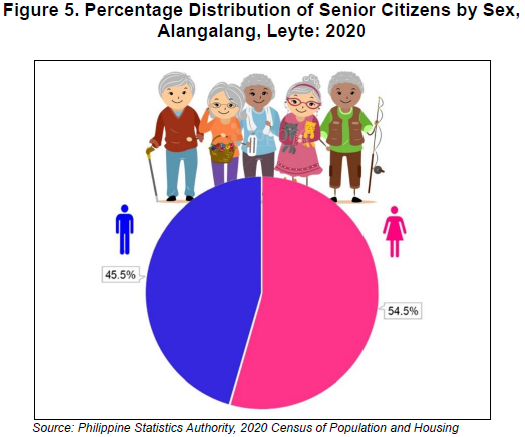
Nearly half of the female population are of reproductive age
Women of reproductive age (15 to 49 years old) totaled to 13,858 or 49.8 percent of the 27,852 female household population in 2020. This figure was higher compared to the 48.0 percent or 12,777 females posted in 2015.
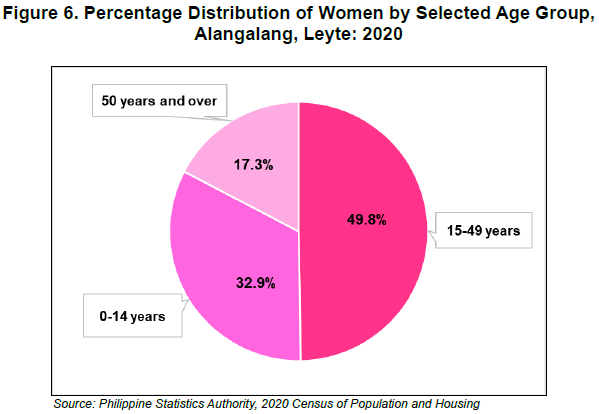
Aging index is higher by 5.2 percentage points from 20.3 in 2015 to 25.5 in 2020
In Alangalang, Leyte, the aging index or the proportion of persons aged 60 years and over per 100 persons under the age of 15 years was computed at 25.5 percent in 2020. This means that there is about one (1) person aged 60 years and over for every four (4) children under 15 years old. The aging index was lower in 2015 at 20.3 percent.

TECHNICAL NOTES
The Philippine Statistics Authority conducted the 2020 Census of Population and Housing (2020 CPH) in September 2020, with 01 May 2020 as reference date.
The 2020 CPH was the 15th census of population and 7th census of housing that was undertaken in the Philippines since the first census in 1903. It was designed to take inventory of the total population and housing units in the country and collect information about their characteristics.
The Philippine Standard Geographic Codes as of April 2022 was used for the disaggregation of geographic levels of the 2020 CPH.
Age refers to the interval of time between the person’s date of birth and his/her last birthday prior to the census reference date. It is expressed in completed years or whole number.
Aging index is calculated as the number of persons 60 years old and over per one hundred persons under the age of 15 years.
Aging of population is a process in which the proportions of adults and elderly increase in a population, while the proportions of children and adolescents decrease. This process results in a rise in the median age of the population. Aging occurs when fertility rates decline while life expectancy remains constant or improves at the older ages.
Household is a social unit consisting of person or a group of persons who sleep in the same housing unit and have a common arrangement in the preparation and consumption of food.
Household population refers to all persons who are members of the household.
Median age is the age that divides the population into two numerically equal groups; that is, half of the population are younger than this age and the other half are older.
Overall dependency ratio is the number of persons under 15 years old (young dependents) and persons aged 65 and older (old dependents) per one hundred persons 15 to 64 years old (working-age or economically-productive group) in a population.
Population pyramid is a bar chart, arranged vertically, that shows the distribution of a population by age and sex. By convention, the younger ages are at the bottom, with males on the left and females on the right.
Sex is the biological and physiological reality of being a male or female.
Sex ratio is the number of males per one hundred females in a population.
SGD. SHERYL ANN A. JAMISOLA
Chief Statistical Specialist

